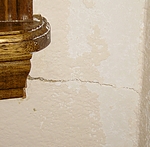 Structural movement is the primary source of cracks in drywall. It can lead to loose corner beads, gaps at the ceiling and along the walls. It can cause cracks that radiate across a wall or ceiling. Whatever the type of crack, most are relatively easy to fix.
Structural movement is the primary source of cracks in drywall. It can lead to loose corner beads, gaps at the ceiling and along the walls. It can cause cracks that radiate across a wall or ceiling. Whatever the type of crack, most are relatively easy to fix.
Corner Bead Cracks
Corner bead is a metal product that defines the corners in many homes. The bead sit on the outside, wrapping around the edge of a corner, and can be square or rounded. As the home moves, the bead can gap along the outside corners.
Often, the first step to repairing gaping corner bead is to locate the nails that are holding the bead in place. You may be able to just tap the nail back into place with a hammer and a nail punch. If this resolves the gap, all you have to do is run some new joint compound over the area, add canned texture as needed and prepare to repaint.
If the bead is metal with paper, you may be able to get the tape to re-adhere using joint compound. If a pucker results, you can experiment with clipping the paper so it lies flat, then continue using joint compound to smooth the area out.
In some cases, you may need to replace the corner bead entirely. This is a different type of repair which is covered here- Repairing Damaged Drywall Cornerbead.
Drywall Stress Cracks
Stress cracks, caused by structural movement, are usually easier to repair. They are typically seen above windows and doors, though you can see them at ceilings as well or anyplace two sheets of drywall butt up against each other.
To fix small drywall cracks, scrape the area clean with a putty knife. Use a razor to widen the crack before repairing it to remove all loose material. The extra width will increase the bonding area for drywall compound. Vacuuming the crack to remove and dust is also a good idea.
Once you have the crack ready, decide what works best for you. You may find using a small putty knife works for you. Or you may find you prefer to put a small amount of compound on one of your fingers and use the finger to fill the crack. While filling the crack rub the spackling paste lightly to minimize sanding. If the wall is textured, the finger method will work best because you can use your finger to mimic the texture.
After completing the repair, apply hand pressure around the crack to check for movement. If there is any, apply drywall screws to the nearest stud. This will make the drywall more solid and reduce the likelihood of future cracks.



Large Drywall Cracks
If you have any large cracks, you will need to tape them just like you would tape the gap between two pieces of drywall. Cover the entire crack with fiber mesh tape for added strength. If the crack is crooked, cut the mesh tape into short lengths. Plan on laying down at least three coats of drywall joint compound, letting the compound dry completely between coats.
If the wall is textured, you will need to remove the texturing for about one inch on either side of the tape. If the texturing doesn’t peel up, you’ll need to sand it smooth. After you have repaired the crack, you can repair the texturing using canned texture. Practice on a scrap of drywall to get the results you want.
It’s possible to patch cracks in drywall so successfully that no one will know they were ever there. It just requires patience.

